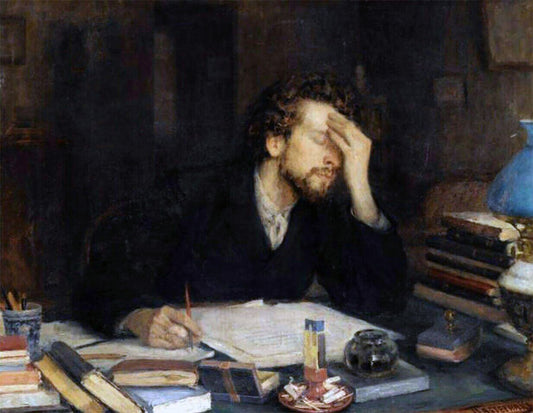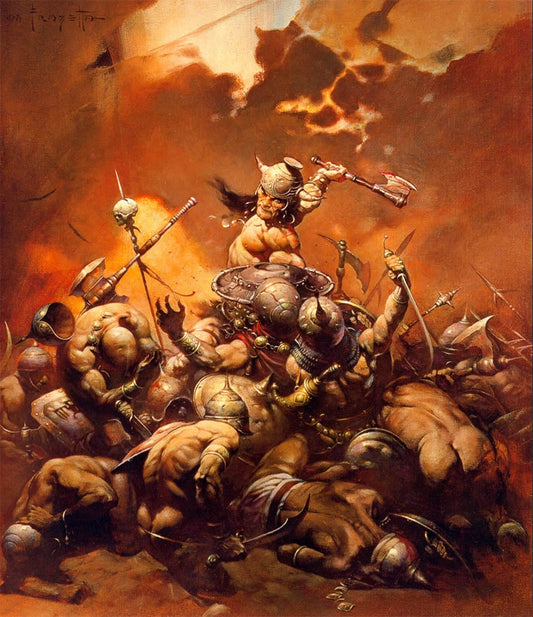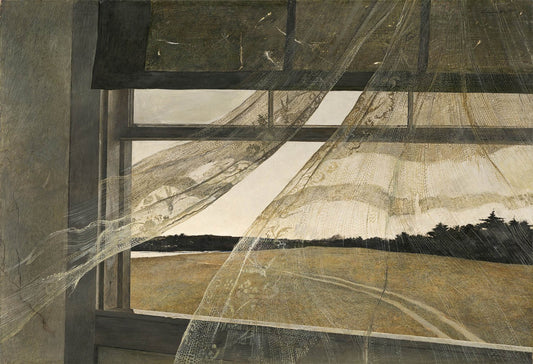The Art of Telling a Whole Story in One Frame
Andreas ClaußenShare
(Or, How Frank Frazetta Turns a Single Image Into an Epic)

Frank Frazetta wasn’t just a master of fantasy art - he was a master of storytelling. Every one of his paintings is like an entire novel condensed into a single, powerful image. You look at his work and immediately, you’re drawn into a world that feels as if it’s existed for centuries. He didn’t need a hundred pages to tell you about the hero’s journey - one image of a warrior standing victorious over a slain beast said it all. Every scar, every muscle, every shadow in the scene suggests history, conflict, and a future yet to unfold. His figures feel alive because they’re frozen at the height of their narrative arcs, at the most critical, intense moment.

Take, for instance, Death Dealer. You see this dark, armored figure sitting atop a massive horse, bathed in shadow and menace. The foggy sky behind him isn’t just a backdrop - it’s part of the story. You don’t just see a warrior - you see the aftermath of a battle, the threat of more bloodshed on the horizon, and the silent question: who or what is next in his path? You can almost feel the earth tremble beneath the hooves of his horse, as if the world itself is bracing for whatever doom he brings.

That’s the brilliance of Frazetta - he doesn’t just capture a moment, he lets that moment breathe, reverberate with meaning. And he does it with such mastery that you’re immediately hooked into the world he’s shown you. The story isn’t finished, but you’re left wanting to know more. That’s what great narrative art does - it pulls you in, and lets your imagination fill in the gaps. You become a participant in the story just by looking.

How the Masters Crafted Their Narrative Art
Frazetta wasn’t the first artist to achieve this level of storytelling in a single image. He followed in the footsteps of great illustrators like Norman Rockwell and Howard Pyle, both of whom were narrative geniuses in their own right. These artists were also driven by the need to tell stories that spoke to the viewer directly, without words. But each had their own approach, their own unique voice that set them apart.

Howard Pyle, often considered the father of American illustration, was a pioneer in this regard. In the late 19th and early 20th centuries, he created images that were filled with adventure, romance, and drama. His illustrations for stories like Robin Hood or King Arthur were more than just visual accompaniments - they were integral to the storytelling. Pyle’s use of dramatic lighting and movement gave his characters life. His compositions were often carefully structured to lead the viewer’s eye through the scene, like a guide walking you through a story.

Norman Rockwell, on the other hand, brought this sense of narrative into a more everyday, relatable context. His illustrations for The Saturday Evening Post were snapshots of American life, each imbued with humor, warmth, or a touch of pathos. A Rockwell painting doesn’t just show you a family around the dinner table - it tells you who they are, what they’re feeling, and the dynamics between them. The tension between a father and son, the joy of children at play, the quiet pride of a small-town doctor - all of these stories unfold in the space of one frame.
Frazetta took the foundation laid by artists like Pyle and Rockwell and applied it to a world of fantasy and adventure. He used the same principles of composition, lighting, and narrative, but he amplified them. Where Rockwell might show a quiet moment of reflection, Frazetta would depict a sword-wielding hero mid-battle. Where Pyle painted knights and pirates in classic poses, Frazetta exploded those forms into exaggerated, hyper-dramatic shapes and movements that practically leapt off the canvas.

Breaking the Rules (With Style and Purpose)
Frazetta didn’t just break the rules of traditional art - he shattered them with purpose. One of the clearest examples is in his treatment of anatomy. Look at his figures - they are exaggerated, muscular, sometimes impossibly so. And yet, they don’t feel wrong. They feel powerful, otherworldly. This is no accident. Frazetta knew anatomy inside and out. He could draw the human body in precise detail, but he chose to distort it to serve his narratives.

In The Barbarian, for instance, the warrior’s body is so massive that it feels almost grotesque by realistic standards. His muscles bulge in ways that are unnatural, but you don’t question it because it serves the story. This isn’t just a man - this is a symbol of raw, untamed power. Frazetta takes the human form and stretches it to its limits, not because he’s ignoring reality, but because he’s bending it to fit his narrative. It’s rule-breaking with intent, and it’s why his figures feel so much larger than life.
Another way Frazetta broke the rules was in his use of color. Traditional academic painters might have chosen more subdued, realistic color palettes, but Frazetta’s were often vivid and fantastical. Frazetta used color not to imitate life, but to amplify the emotion and intensity of the scene. That’s the key - every choice he made, whether it was anatomical exaggeration or surreal color, was always in service of the story.

The Importance of Finding Your Voice
What artists like Frazetta, Rockwell, and Pyle all have in common is that they found their voice. They didn’t just mimic what came before - they took the rules, learned them, and then reshaped them to fit their own vision. This is something every artist must grapple with - the search for a unique voice. It’s not enough to be technically skilled or to paint what’s expected. The real challenge - and the real reward - comes from figuring out how to make your work unmistakably yours.
Frazetta’s voice is unmistakable because it speaks directly to our primal emotions - fear, awe, power, vulnerability. You look at his work, and you feel something, even if you can’t quite put your finger on what that feeling is. That’s what makes his art so powerful. He wasn’t afraid to take risks, to exaggerate, to push boundaries, because he knew exactly what he wanted his art to say.
Finding your voice as an artist takes time, and it often involves a lot of experimentation and failure. But it’s essential. Without it, your work risks becoming just another image among millions. With it, your art has the power to connect, to resonate, to tell a story that no one else could tell.

Emotional Impact in Art
The most successful narrative art - whether it’s Frazetta’s epic battles, Rockwell’s quiet Americana, or Pyle’s swashbuckling adventures - doesn’t just tell a story. It makes you feel something. That emotional impact is what separates great art from merely good art.
Frazetta’s art hits you in the gut. It’s visceral. His characters aren’t just going through the motions - they’re living, breathing, and fighting for their lives. You can feel the weight of a sword, the tension in a battle stance, the exhaustion after a long fight. This emotional connection is why his art endures. It speaks to something deep and universal, something that resonates with the viewer on a level beyond logic or analysis.

The best art doesn’t just show you a scene - it makes you experience it. It invites you to step inside the frame, to feel what the characters are feeling, to live in that world, if only for a moment. That’s the real magic of artists like Frazetta. They don’t just paint pictures - they create experiences.
And that’s where the lesson lies for all of us. It’s not about mimicking the greats like that came before us - it’s about learning from them, understanding the principles behind their work, and then finding your own way to tell stories that connect with people. Whether it’s through fantastical worlds or quiet moments of reflection, the power of art lies in its ability to evoke emotion and spark the imagination. So, take risks, break rules, and, above all, find your voice - because that’s where the real story begins.




